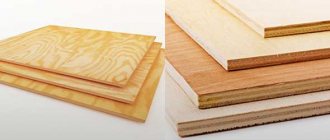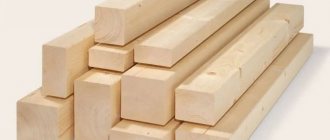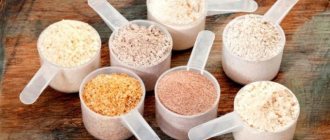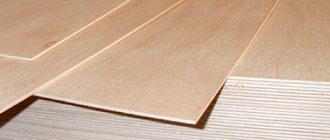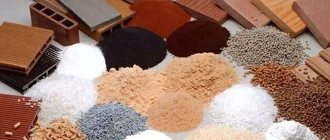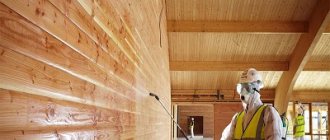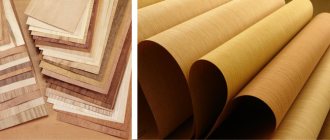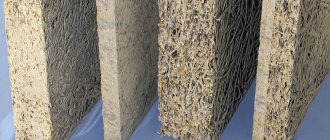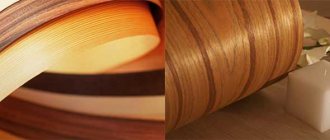Types of fiberboard
According to the methods of production and further use, fiberboard slabs are classified into the following types:
- soft;
- semi-solid;
- superhard;
- ennobled.
Soft fibreboards are highly porous, however, they have low strength, so they are not used as the main material. They have found their application in construction during the installation of sound and heat insulation systems.
Semi-hard fibreboards , compared to soft ones, have significantly greater density and hardness and are able to withstand impressive loads. They are widely used in the manufacture of furniture structures: back walls, shelves and drawers.
Superhard fibreboards are distinguished by high quality workmanship and have increased density. Their undoubted advantages include ease of processing and ease of installation. Basically, they are purchased for the manufacture of arches, doors, partitions and various types of containers. In addition, they can be used as flooring.
Treated fiberboard is characterized by a carefully processed surface, onto which a dye is applied, after which the fiberboard is cached. To impart special decorative properties, a pattern can be applied to the surface. Wood imitation is especially popular. The main advantage is its beautiful appearance, but the disadvantages include the rather high cost and the impossibility of using it for some purposes.
LDVP or laminated fiberboard are classified into a separate group. They are fiberboard sheets coated with a composition of synthetic resins, which increase the moisture resistance and strength of the material.
Fibreboard production
The increasing cost of resources and concern for the ecological state of the environment forces many manufacturers to invent new building materials and introduce technologies that can significantly save raw materials without much damage to the quality of the final product. A clear indicator of such changes is the sphere of furniture production, where natural solid wood has been replaced by various synthetic materials.
Fiberboard sheets are widely used in furniture production
The first imported furniture, which was imported into our country in the second half of the twentieth century, with its aesthetic and durable design, showed that waste from wood processing can be used for manufacturing. Further development of fiberboard production technology has made it possible to bring the appearance of the material closer to natural wood, enriching the slabs with a special film similar in texture to wood. The production of laminated fiberboard has increased exponentially. Today this material can be purchased at a very affordable price. The sizes of the laminated fiberboard sheet are different and will satisfy any, even the most non-standard, consumer request.
Dimensions of fiberboard sheet
Due to its unique protective and thermal insulation characteristics, fiberboard is successfully used in the construction and repair of various wooden structures and for the production of wooden products.
Fibreboard slab thickness parameters
As a rule, the thickness of fiberboard ranges from 2.5 to 5.5 mm, which is considered a fairly thin material.
Low and medium density slabs are produced in the following thicknesses: 8, 12, 16 and 25 mm.
Semi-solid slabs are produced in thicknesses of 6, 8 and 12 mm.
Plates of hard and super-hard grades have a thickness of 2.5, 3.2, 4.5 and 6 mm.
With the correct selection of fiberboard, construction and cladding work is greatly facilitated, which in addition provides significant financial savings.
Length and width of fiberboard slabs
Fiberboard sheets, for all their thinness, have an impressive area. Their length can be from 1220 to 3000 mm, and their width can be from 1220 to 1700 mm.
The maximum existing size of fiberboards available for sale can be 6100x2140 mm, which is more likely applicable for industrial enterprises rather than for home purposes.
Why do you need to know the dimensions?
Fiberboards, which have a denser structure, are also called hardboard. The raw materials for the production of boards are waste from wood processing industries and wood. In some cases, waste paper is added. Wood chips are processed, crushed into shavings, then they are ground into fibers, which are then mixed with all the components. The binding agent is glue or resin.
This material is suitable both for renovation work in the house and for the design of furniture. Fiberboard has a lower cost than natural wood. Also, its main advantages include moisture resistance and large sheet size. Dense fibreboards have greater ductility and low weight, and their characteristics do not change for a long time even when exposed to water.
When purchasing, it is worth assessing panel parameters such as their density, weight, storage conditions and movement of raw materials. One of the important roles is played by the thickness and area of the fiberboard. There are many types of panels, but there are certain parameters that are important. In addition, the deviation that can be allowed for sizes above the norm is calculated, since this affects the working area, the strength of the product, and the amount of waste.
Correctly selected thickness helps save money. You need to know the thickness of the sheets so that the material can be used economically and efficiently.
The most popular sizes on sale range from 1 to 3 meters in length and 1-2 meters in width. It is quite difficult to transport such a structure, but the cost compensates for all the disadvantages. And large slabs are suitable for construction on an industrial scale.
Solid sheets are used for finishing rooms. The area is calculated so that a spare part remains, which is used for cutting. Small pieces can be purchased from special companies or woodworking factories. Economical cutting is carried out using measurements of the room (ceiling, walls and floor).
The next stage is drawing up diagrams and cutting out the material. It is important to correctly calculate the parameters of the room and purchase the required number of sheets of fiberboard. As a result, the choice becomes the option that will provide the most efficient consumption of materials. A material with a small thickness and a significant area is most easily deformed. If you need a more flexible group, then you should choose softer fiberboard.
Types of hard fiberboard brands
Solid fiberboard boards are available in certain brands:
- T – hard with untreated front layer;
- T-P – solid with a colored outer layer;
- T-S - solid with a lining of fine wood mass;
- T-SP - solid with a lining made of fine wood pulp and a painted outer layer;
- ST – super-hard slabs with an untreated outer layer;
- ST-S – super-hard slabs with a cladding made of fine wood pulp.
According to the physical and mechanical characteristics of fiberboard slabs of brands TP, T-SP. TS and T are classified into groups: A and B.
According to the quality indicators of fiberboard surface treatment, slabs of these brands are classified into grades I and II.
Advantages of fiberboard
Fiberboard has a wear-resistant coating. It is easy to care for and can be cleaned with any detergent, including aggressive ones.
The advantages of fiberboard are obvious:
- high thermal insulation;
- good sound absorption;
- ease of processing;
- long operational period;
- small parameters of weight and thickness with a high level of rigidity;
- affordable price;
- wide size range of slabs.
Despite the impressive list of advantages, it would be wrong to say that fiberboard is a universal material; it also has its disadvantages:
- low resistance to lateral bending load;
- When purchasing a non-certified product, there is a high risk of the presence of toxic compounds in the adhesive component.
The manufacturing features of the slabs do not allow them to be made with the same bending resistance in different directions. When bending transversely, the slab may break. Therefore, when manufacturing complex structures where it is necessary to bend the radius, you should act with great care. When covering vertical surfaces with fiberboard, the material must be pressed as tightly as possible to the base, eliminating the formation of gaps - the presence of air cushions often leads to creases. It should also be borne in mind that wood-fiber sheets are quite thin, so they can be destroyed under strong mechanical stress.
Types of fiberboard
Depending on the area of application, fiberboard sheets vary in type. Untreated fiberboard, as a rule, is not painted with anything and is often used in the production of furniture and frame structures that are not exposed to environmental conditions.
Painted fiberboard first goes through a primer stage, and then paint or varnish is applied to the sheet. This type is highly functional; they can be used in various areas, as they are almost resistant to moisture. Another type of fiberboard is covered with fine wood pulp. At first glance, it can resemble lamination and can repeat a large number of textures. Also, such sheets are not afraid of moisture and mechanical stress.
Fiberboard is laminated, it is the most durable and aesthetically pleasing. The front side is treated with a special polymer coating and has higher strength and functionality compared to other types.
What is this
The modern name of the building material is fiberboard, fibreboard. Available in sheet form. In production, wood fibers are used, processed with hot water, followed by pressing and drying.
Description
Based on structure, density and purpose, fiberboard is divided into soft or hard types. Kragis are soft pressed wood varieties. This type of product is known to a wide segment of the population as furniture boards. It was used to cover the back walls of cabinets, sideboards, bedside tables, etc. The practice was to lay sheets on a wooden floor, followed by painting.
The front side of the product has a smooth hard surface. The reverse side is made in the form of a structural plane, reminiscent of a classic waffle or mesh. The material is divided by brand. Soft: M–1, M–2, M–3. Density does not exceed 350–400 kg/m³. Hard: T, T–S, T–P, N–T and others. Density 600–850 kg/m³. The difference from soft is a different manufacturing technology, the introduction of various resins and mineral additives into the composition. Geometric parameters:
- thickness 2.5–25 mm;
- length 2140, 2440, 2745, 3000 mm;
- width 1220, 1750 mm.
Soft types are used mainly as heat and sound insulation materials. This is facilitated by the internal loose structure of the slab. This type can be found when opening the floor during repair work: cuttings of slabs are placed under the joists. They also fill the space between the wall and the side surface of the laid wooden floor.
The name and technical manufacturing conditions are regulated by:
- GOST 27935-88 (ST SEV 6014-87) “Fibreboards and particle boards. Terms and Definitions".
- GOST 4598-86 (ST SEV 4188-83) “Fibreboards. Technical conditions".
Often, the name “kragis” is confused with “hardboard” - hard and special types of fiberboard. In fact, “kragis”, in its commonly used meaning, is the most common type of fiberboard manufactured and used in our country. The product has dimensions of 3.2 x 1220 x 2745 mm.
Application
The use of wood processing waste and a fairly simple and proven technology made it possible to create a product with a low price. The physical and mechanical properties of the material predetermine the areas of application:
- Furniture manufacturing:
- back walls of clothing, book and kitchen cabinets;
- finishing the back side of wall-mounted and floor tables, chests of drawers, shelving;
- shelves for light loads and other furniture elements.
- Construction:
- installation of partitions;
- production of paneled interior doors;
- as an intermediate floor covering;
- Laminated fiberboard sheets are used to cover walls in residential and industrial premises.
- Trade and logistics services. Due to their low price, softness and, at the same time, sufficient rigidity, kragis sheets are used as a cushioning material when transporting household and industrial items.
Plates are used to form partitions in car bodies, as a heat and sound insulating material.
Density and weight
Fiberboard is made from wood that has been ground into fibers. The fibers are then pressed under high temperature into a homogeneous raw material. Flax fire and reed waste also help in the formation of tiles. The source is crushed into chips and boiled in an alkaline solution. After which the resulting raw materials are pressed under elevated temperature and high pressure (10-50 kgf per 1 cm). Depending on the level of pressing of wood fiber fabric, several types can be distinguished:
- Plates with super-hard density have a volumetric mass of 950 kg per 1 m2.
- Solid panels with a volumetric weight of at least 850 kg per 1 m2.
- Semi-hard tiles with a weight of 400 kg per m2.
- Finishing panels with a weight of 250-350 kg per 1m2.
- Insulating products weighing up to 250 kg per 1m2.
One of the important characteristics of fiberboard is density, which affects the weight of the product. The minimum density is 800 kg per m³, and the maximum value is 1100 kg per m³. In order to determine how much all construction raw materials weigh, calculate the sum of the volume of the entire batch and multiply the resulting number by the density value. The exact density number is indicated in the documents. The builder will then know which transport to order.
Products with a soft composition and low density perform a decorative function. The maximum value is no more than 400 kg per m3. The minimum density value is 100 kg per m3. For panels with an intermediate density value, the minimum number corresponds to 600 kg per m3.

